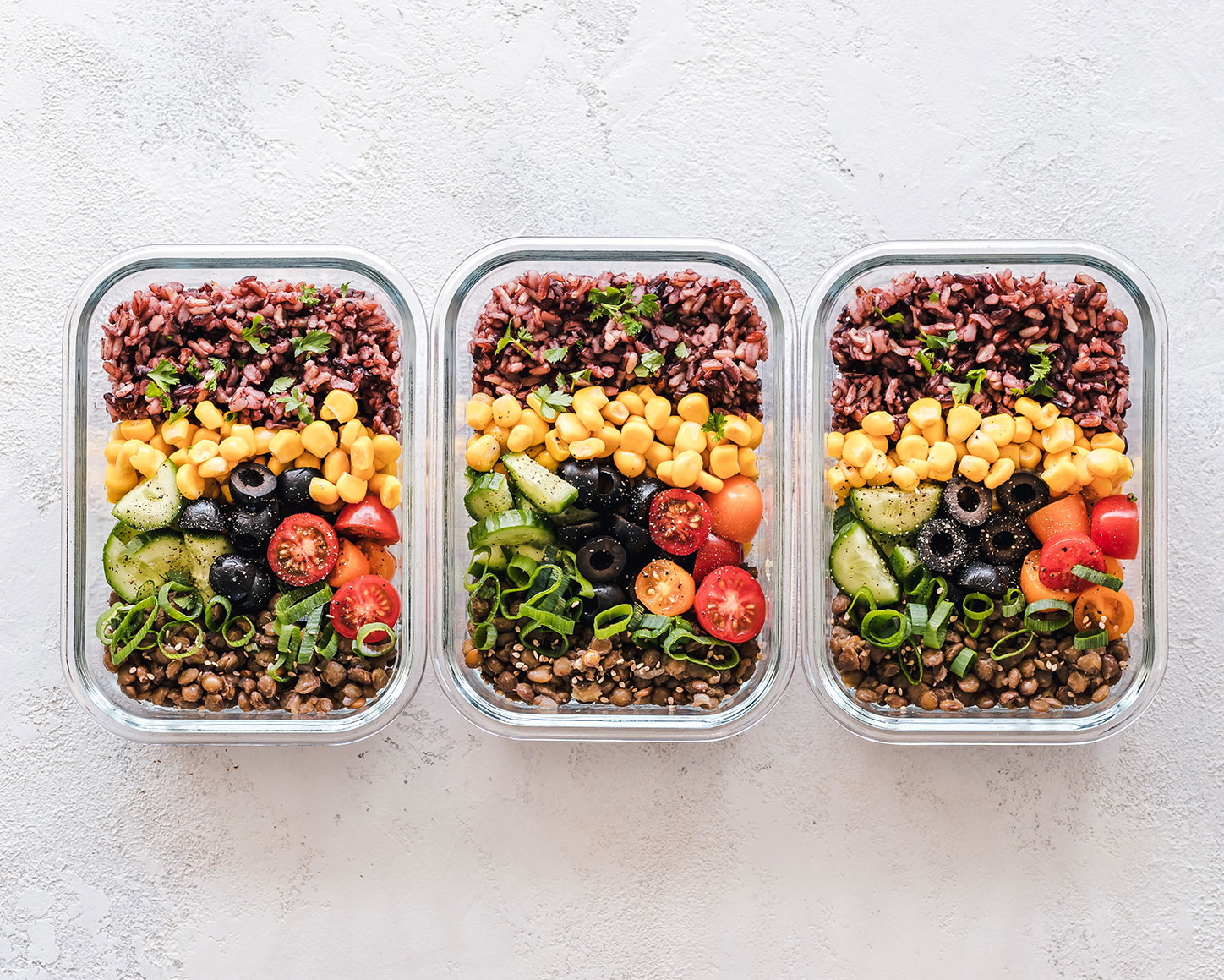Picture this scenario:
You come home after a long day at work, and you’re starving. You’re also exhausted. You have food in the house, but you haven’t taken anything out of the freezer to thaw, and what you have in your pantry will take at least an hour to prepare. What happens next? If you’re like most people, you run out to pick up some fast food or resign yourself to ordering takeout.
Planning ahead is a discipline, and there’s no doubt about it—while making food from scratch is cheaper, it can also be time-consuming. Services like Uber Eats and Doordash are super convenient, but the money adds up. And really, who wants to cook when you’re already exhausted from work and other responsibilities?
However, there is a way for you to have the best of both worlds. Tastier, homecooked—and probably infinitely healthier—meals are possible with a little bit of planning and some meal prep tricks up your sleeve. Once you get the hang of it, you’ll prefer food from your own kitchen much more than a costly meal from a nearby restaurant. Plus, you’ll save a boatload of money.
In this post, we’ll discuss the most budget-friendly ways to meal-prep and how to get started. Ready to live a rich life even on a tight budget? Dig in for some delicious ideas.
Meal-Prep-Getting Ready
One of the most time-consuming aspects of preparing meals ahead of time is the planning that goes into it. But once the ball is rolling, it becomes second nature. So here’s how to get started:
- Head to your kitchen cupboards or pantry and start going through them. This will be the most laborious part of the process, but you’ll only have to do it every few weeks if you play your cards right. Pick up each item, taking note of the expiration dates. Toss the expired stuff and make a donation box of the things you know nobody is ever going to eat (we’re looking at you, creamed corn).
- Next, move on to your refrigerator. Get rid of everything gross, expired, or past its prime, like that relish you’ve had for five years but feel guilty about throwing away. This is no time to be sentimental. If you’re not going to eat it, toss it. Now do the same with everything in your freezer.
- Grab a notebook and a pen. Make a list of everything left and start planning what you would like to have for dinner the next few days. Once you get better at it, you’ll be able to plan at least a week—maybe two—ahead. But for now, just focus on the next two or three dinners. This will also help you use the pantry items you already have, so this project saves you cash right out of the gate.
Planning Makes Perfect
Your menu will vary depending on your eating habits, but we’ll start with some hypothetical meal ideas. Let’s imagine you plan to have chicken breasts from your freezer, rice from your pantry, and fresh carrots on the first night. For the second night, you could cut up the leftover chicken, add a jar of spaghetti sauce and a box of pasta, and have chicken cacciatore. The third night, maybe bake some potatoes and have frozen fish and a salad.
Your meal choices are inconsequential. What is important is consciously planning to prepare most of it ahead of time. That way, you only have a few steps once you get home. Using the imaginary menu above, let’s make a plan:
- On Sunday night, take the chicken out of the freezer and place it in the fridge to thaw. If you want to get fancy, make a marinade and cover it until it’s time to put them in the oven the next night.
- Now on to the carrots. Pull them out of the fridge and peel and chop them. Throw them in a zip-lock bag or a storage container. Now the carrots are ready to add to a pan of water Monday night.
- For the rice, you can even pre-measure that too. You could even go as far as putting water in the pan for boiling or steaming when you get home from work.
- If you’re unsure of the timing or oven temperature for any items, google it now. For instance, make a note that chicken breasts go in for 15-20 minutes at 450 degrees and stick it somewhere you will be sure to see it.
Now when you arrive home the following evening, all you need to do is turn on the oven, put the carrots and rice in some saucepans, and your dinner will be hot and ready within a half hour. That’s about as much time as it will take to change out of your work clothes and relax for a few minutes.
Make the same preparations after dinner (or before work in the morning) for Tuesday night’s supper. Again, pre-measure, chop, look for instructions online—do whatever you can to make it simpler to cook when you come home. Then, repeat the process with Wednesday’s meal.
Build on Your New Skills
Once you give meal-prep a try for a few nights, tack on a few more nights. Try to make a game of staying on top of the planning, and you will always have something tasty for dinner. By now, it should be time to get a few groceries. Again, make a list of what you would like for meals, but plan for a whole week this time. You’ll get more organized and better at planning with every week that passes.
Many veteran meal-preppers don’t even use a list. Rather than creating the week’s menu before they shop, they shop first to see what’s on sale, planning each night’s supper on the fly as they peruse the aisles. To take the savings even further, those who are super-skilled at this game do all of that PLUS use coupons to save even more money!
Tools of the Trade
Once you’ve mastered the art of meal planning, you can start to invest in some handy tools to make your life even easier. Of course, you don’t want to sabotage your plans to save money on food by spending money on kitchen gadgets, either, so you’ll need to find a balance.
Remember, you can get by with the most basic kitchen pots, pans, and utensils. However, at some point, you may want to invest in a few things for your own pleasure and convenience. Here are a few practical items to consider
Slow Cooker
Of all the meal-prep gadgets that exist, the slow cooker—or Crock-Pot—is arguably the handiest of them all. That’s because you can throw in a few ingredients, turn it on, and have a hot and ready dinner when you return home. They come in all different sizes and styles, so be sure to shop around for one that will meet your family’s needs. As a bonus, you can find thousands of slow cooker recipes online that will suit even the fussiest eater.
Food Processor
Depending on the size of your family and how ambitious you want to be with meal prep, a food processor can save you tons of time. You can chop, shred, grind, mix, knead, mince, puree, and more with them. If you go through a lot of pre-bagged shredded cheese, for example, you can save yourself some time (and money) by buying blocked cheese in bulk, then shredding it, bagging it, and freezing it for later in just a few minutes.
Good Knives
If you do a lot of food prep, you already know that having sharp, high-quality knives is imperative, not only because they get the job done but because they are actually safer in the kitchen than dull ones. They don’t come cheap, though. Don’t waste your money on knife “sets” that are packaged with a dozen different knives when you really will only use two or three types. Instead, determine the ones you need the most (a paring knife, bread knife, and a chef’s knife, perhaps) and purchase them one by one as your budget allows.
A Word About the Added Expense of Kitchen Tools
When you’re trying to live on a shoestring, you don’t want to turn a money-saving hobby like cooking into an expensive ordeal. However, you probably need to pick up a few items to make things easier in the kitchen, too. Here are a couple of suggestions:
Ask Around
Ask your friends, neighbors, or relatives before you head to the store or order something online. More often than not, people have spare kitchen gadgets and tools they no longer use that they would be happy to part with.
Check Thrift Stores
This is the next best thing to free, and a sensible idea. Scour your local Salvation Army, Goodwill, and thrift stores. These second-hand shops usually have an abundance of home goods you can purchase for next to nothing.
Earn Some Extra Cash With a Side Gig
An easy side-gig can help you afford some basic needs without taking from an already-stretched budget. You could make money doing surveys, advertise dog-walking services, sell unwanted stuff online, or something altogether different.
Moving Forward
Not everyone loves to cook, and that’s okay. You may find that it’s just not your thing. But you also may surprise yourself and learn that enjoying your own healthy and cheap homemade meals is fun, empowering, and a huge money-saving activity.
As you become more skilled at meal preparation, you might even get bold enough to plan your meals a month (or more) in advance. Did you know there are entire websites, forums, and clubs devoted to Once-a-Month Cooking? Check some of them out!
As you become better at meal prep, you should strive for consistent progress, but don’t expect perfection. There will always be those times when you can’t make it to the grocery store or you’re feeling too worn out to plan ahead. But don’t beat yourself up over it. If you’ve grown accustomed to fast food or ordering out, even implementing this plan a few times a week is going to have a positive impact on your finances!












